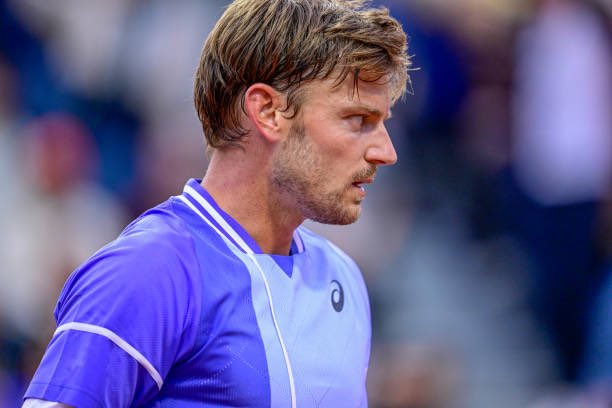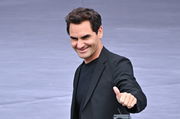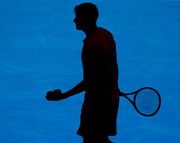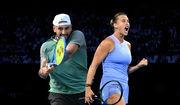

The sun has set on the Shanghai Masters, leaving behind a whirlwind of drama, upsets, and history-making moments. Two unseeded players shocked everyone by reaching the final, and a World No. 204 lifted the trophy for the first time ever. But the highs came with their share of lows. As Novak Djokovic put it after a gritty win over Marin Cilic, “I don’t remember the last time I played in humidity like this. It is what it is… It’s the same for me, my opponent, and every other player.” With the mercury hitting 30°C (86°F) and humidity clinging at 80 percent, the conditions took a toll. Even defending champion and top seed Jannik Sinner had to call it quits. But David Goffin had a different take.
Watch What’s Trending Now!
The Belgian began the week in top form. He opened with a solid win over Alexandre Muller, then stunned sixth seed Ben Shelton in the next round. But his run ended abruptly in the Round of 16. Goffin retired after just twelve minutes, citing injury. What was meant to be a proper showdown turned into another reminder of how brutal the Shanghai conditions were.
Yet even after his early exit, Goffin stood firm in his beliefs. He told reporters, “The top 10 players often go far in tournaments so they play a lot. And when the end of the season comes, with this special tournament, played in temperatures almost 35 degrees (unheard of), and with a humidity level of 80%, it’s extremely tough. In addition, the surface has been slowed down, so the rallies are longer. In the last part of the season, the bodies are tired. For some, it’s difficult. But we’ve always had tournaments from January to November. And everyone plans their schedule as they wish.” But was he right?
ADVERTISEMENT

Imago
Image Credits: Instagram | David Goffin
Well, not quite. The “slowed down court” debate heated up after Roger Federer suggested tournaments might tweak surfaces to favor World No. 1 Jannik Sinner and No. 2 Carlos Alcaraz, helping them reach finals and boost buzz. Alexander Zverev agreed but exited early, falling in the Round of 32 to eventual finalist Arthur Rinderknech. The World No. 2, though, shut down the rumor, saying neither he nor Alcaraz had any say over court speeds or tournament decisions.
As for the players struggling with the conditions, Goffin and Sinner weren’t the only ones. Tomas Machac, Casper Ruud, Hamad Medjedovic, Terence Atmane, and Wu Yibing were among those forced to retire under the oppressive heat. Even those who kept playing openly criticized the ATP for not enforcing a heat rule like the WTA’s.
ADVERTISEMENT
Holger Rune was one of them. He questioned an umpire mid-match and got the response that it was “a good question,” but there was no answer. Rune shot back, “You want players to die on the court?” The heat’s toll was evident across the draw, even for four-time champion Djokovic and Daniil Medvedev.
Djokovic vomited in two matches due to the brutal conditions. He even collapsed after dropping a set to Jaume Munar while nursing an injury scare. Medvedev looked visibly drained and gasping after his Round of 32 win over Alejandro Davidovich Fokina. Both men made it to the semifinals but couldn’t push past that stage. Still, the lingering question remained: why didn’t the ATP step in to implement a heat rule like the WTA’s?
ADVERTISEMENT
While Goffin argued that players should’ve been ready for it, the reactions of his peers told another story. The outcry was so intense that it eventually prompted an official statement from the ATP.
Ahead of David Goffin’s callout, ATP reveals a plan for the heat
Following the wave of withdrawals and frustrated voices from the players, the ATP finally broke its silence. In an email to Reuters, the tour said, “In parallel, the ATP Medical Services team implements several measures in cases of extreme heat, to help protect player health during competition.” The statement added that change could be on the horizon. “This remains under active review and additional measures, including the implementation of an official heat policy, are currently being evaluated in consultation with players, tournaments, and medical experts.” The ATP was clear about one thing: “Player safety remains a top priority for the ATP.”
ADVERTISEMENT
That said, the men’s tour still lags behind other major bodies when it comes to heat protocols. The WTA and Grand Slam events have formal systems in place, like the Australian Open’s five-point heat stress scale, but the ATP still relies on case-by-case judgment calls from on-site supervisors and medical staff. In other words, there’s no universal rulebook yet, just reactive decisions when things get steamy.
Holger Rune, for one, wants that to change. After his win over Perricard, the Dane didn’t mince words. “Yes, I think there should be a rule regarding the heat, like there is in the Grand Slam tournaments. I think all the players would agree on that. Today was better, as you say, it was less hot. But again, it was less hot, but if the temperature had been more normal, it would have been very hot today.” He also wasn’t too optimistic about what’s next, adding, “I think it was around 31 degrees and the humidity was very high. But compared to other days, it was quite brutal.” And with temperatures expected to cross 90°F soon, he’s not wrong to be worried.
Top Stories
Roger Federer Sparks Comeback Frenzy After Huge Australian Open Announcement

Martina Navratilova Drops 3-Word Message in Aryna Sabalenka’s Support Over Her Recent Comments

26YO ATP Pro Handed 20 Years of Suspension After Breaching 27 Anti-corruption Programs

Aryna Sabalenka Breaks Silence on Nationality Switch After Belarus Representation Ban

Nick Kyrgios Defends Aryna Sabalenka Amid Billie Jean King’s Criticism

But not everyone sees it that way. David Goffin stands firm that players should know what they’re signing up for and plan their schedules accordingly. His stance might clash with many others, setting the stage for a heated debate. What do you think? Drop your thoughts in the comments below!
ADVERTISEMENT
ADVERTISEMENT
ADVERTISEMENT
ADVERTISEMENT

